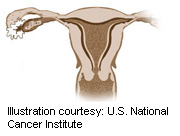
WEDNESDAY, June 29 (HealthDay News) — In the largest such study of any tumor type to date, scientists say they’ve gleaned an in-depth look at genes that may help drive aggressive ovarian cancer.
The achievement, which could lead to a better understanding of this “silent killer” and ways to treat it, comes as part of The Cancer Genome Atlas (TCGA) Research Network. That project was launched in 2006 by the U.S. National Cancer Institute and the U.S. National Human Genome Research Institute.
“We have now a map that is telling the cancer research community where to look and what to work on in the future,” explained study lead author Paul T. Spellman, who conducted his research while a staff scientist at the Lawrence Berkeley National Laboratory in Berkeley, Calif. “The public should know that this is not an answer in itself. But before this we were essentially making guesses. Now we actually have a very good road map.”
The findings are published in the June 30 issue of Nature.
According to the American Cancer Society, ovarian cancer is the fifth most common cancer among women, but it is especially lethal because it is often caught too late for effective treatment. Nearly 14,000 American women died of ovarian cancer in 2010, the cancer society said.
The new genomic research looked specifically at high-grade serous ovarian adenocarcinoma (HGS-OvCa), the most common form of the disease, which accounts for roughly 85 percent of all ovarian cancer deaths. Looking at 316 tumors, the researchers focused on what’s called “whole-exome sequencing,” examining those regions of the genome that deal with protein production. These types of examinations, along with others, were also conducted on another 173 ovarian tumor specimens.
“This battery of analyses is a big step up in characterizing the many different kinds of changes that can cause cancer, in this case ovarian cancer,” Spellman explained.
Among some of the main findings:
- There appear to be four different subtypes of HGS-OvCa, as well as four more additional related subtypes, based on the genetic scan.
- Abnormalities present in a key gene, called TP53, were found in nearly all (96 percent) of patients diagnosed with these tumors.
- Just over one in every five of the tumors were found to have tumor mutations in the BRCA1 and BRCA2 genes, which have long been linked to risks for both ovarian and breast cancers. In this case, patients whose cancers carried these mutations had better survival rates than those who did not.
- Overall, specific patterns in 108 genes were also linked to poorer survival, while those for another 85 genes were linked to better outcomes. Patients with genetic activity deemed “poor” were found to have 23 percent shorter survival than those without such genetic aberrations.
The genomic scan also points to tantalizing new leads for potential treatments, the researchers said.
For example, mapping also revealed 68 genes that could become appropriate therapeutic targets for medications — either drugs already approved for cancer treatment by the U.S. Food and Drug Administration or drugs still under development, the researchers noted.
According to the team, as many as half of all the aggressive ovarian tumors they studied might respond to drugs that focus on genetic weaknesses in the tumor to help induce cancer cell death.
Dr. Andrew Berchuck, director of the gynecologic cancer program at Duke Cancer Institute in Durham, N.C., said that the main point here is that “not all ovarian cancers are alike.”
“What’s basically been done here is an autopsy,” he explained. “A forensic analysis of tumors. And what they find is that the molecular changes that occur in one case of ovarian cancer can be dramatically different from that of another in terms of what’s gone wrong in terms of cell growth and cell death,” he added.
“This was suspected to be the case,” said Berchuck, who is also a member of the TCGA ovarian cancer working group, and a spokesperson for the Foundation for Women’s Cancer. But, “no one’s ever mapped it out in extraordinary detail like this before, so that we can begin to understand the biology and root causes of what’s going on,” he pointed out.
“For patients, what’s important is that we can now look at an individual cancer and characterize the molecular alterations that have caused that specific cancer to arise,” Berchuck said. “And then those alterations become therapeutic targets for treating that particular cancer. So it really ushers in the potential for personalized medicine, in which you’re not treating all ovarian cancers in the same way. Of course, it’s a big leap between that knowledge and being able to do something about it. But this represents a major step in the right direction.”
More information
For more on ovarian cancer, visit the U.S. National Institutes of Health.

